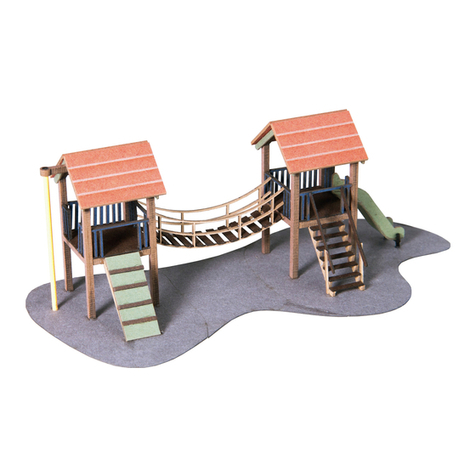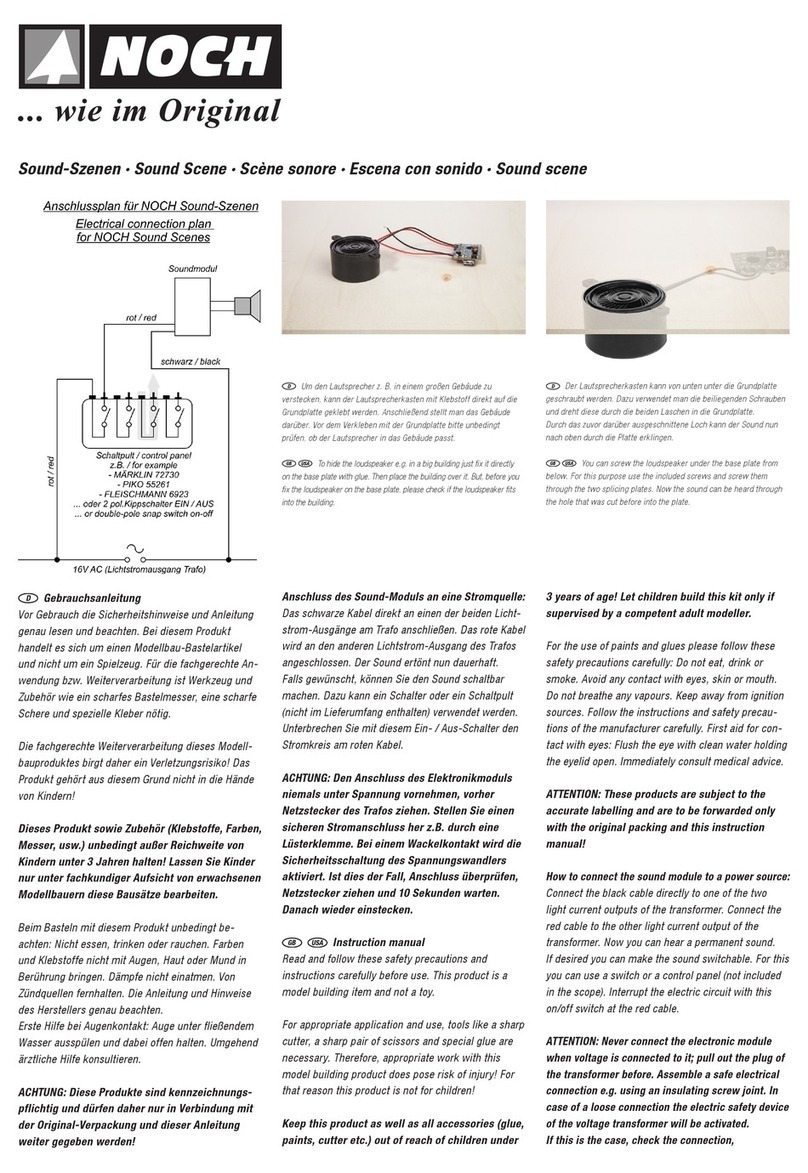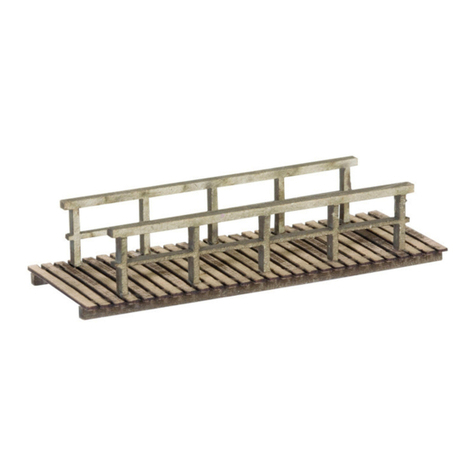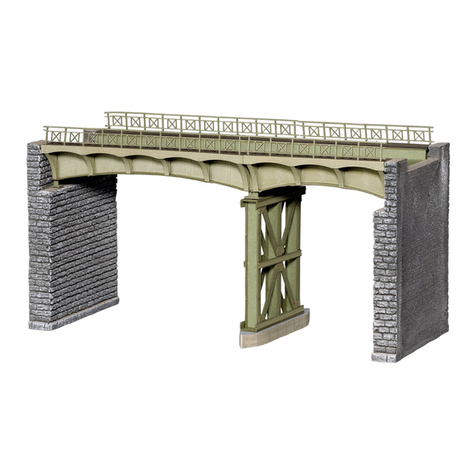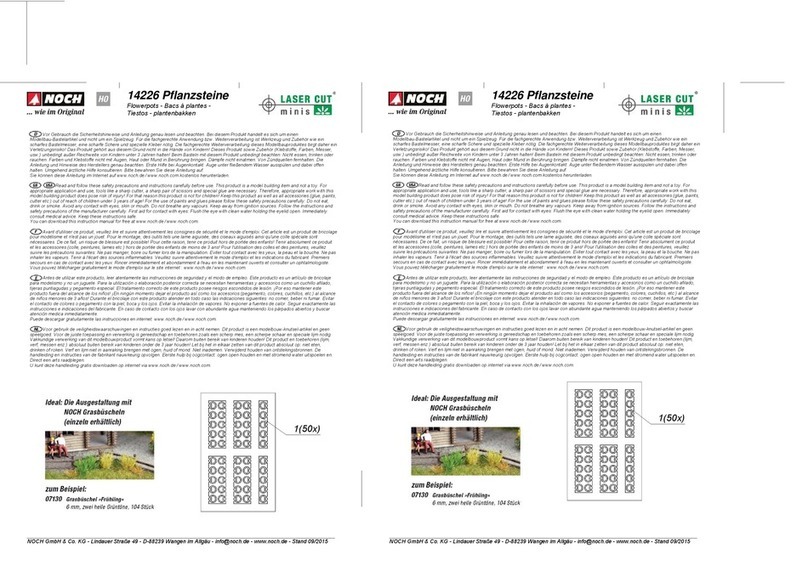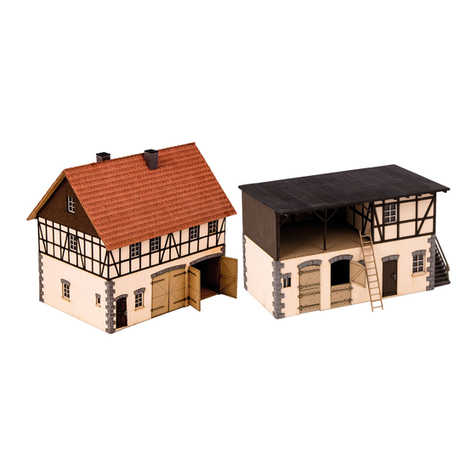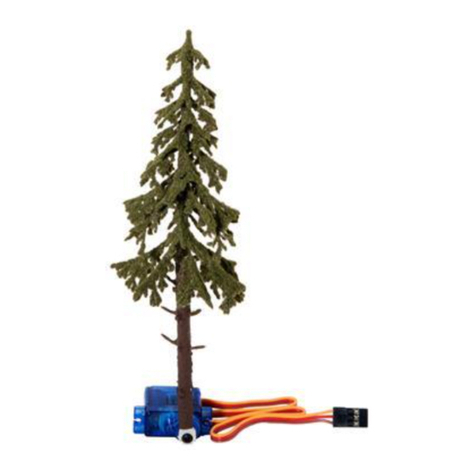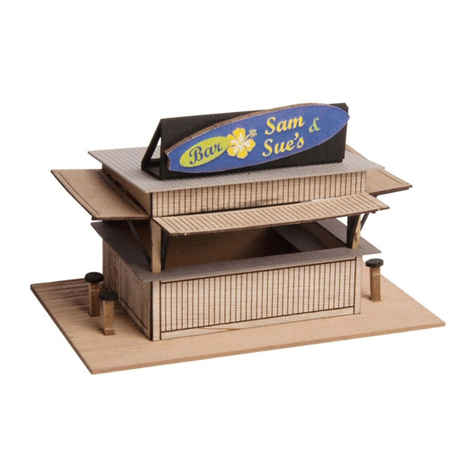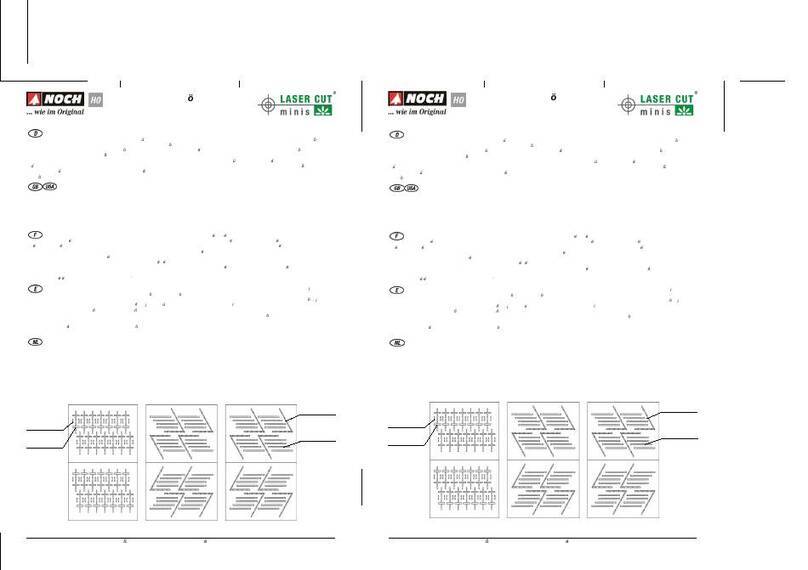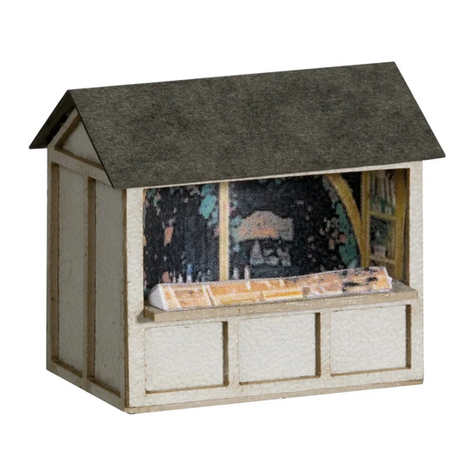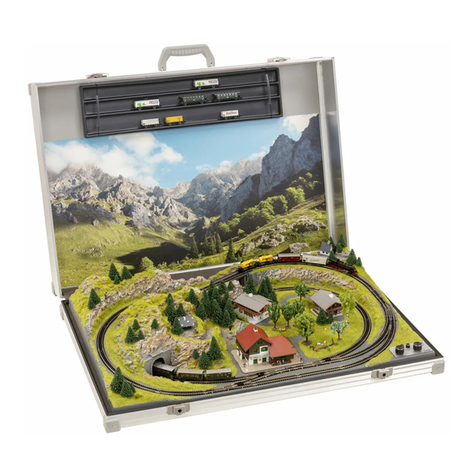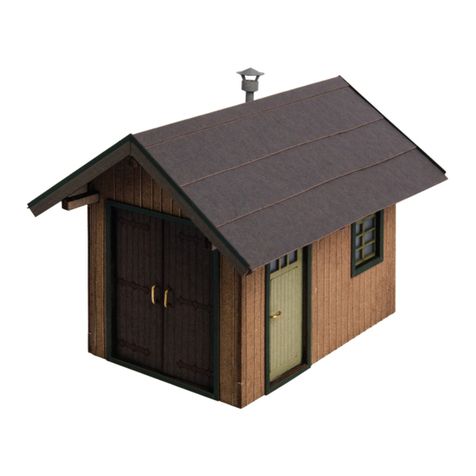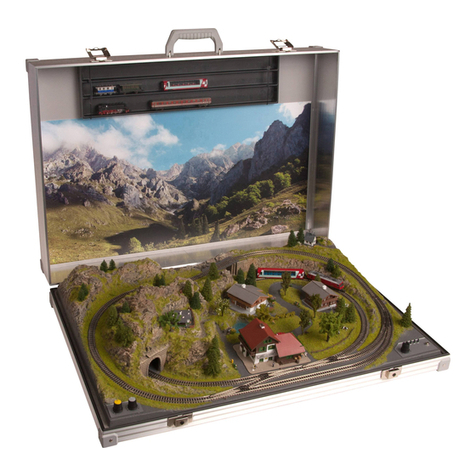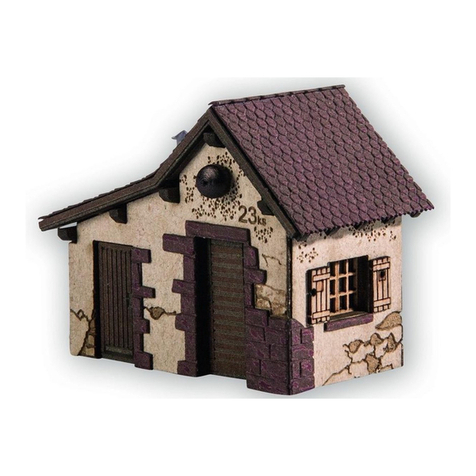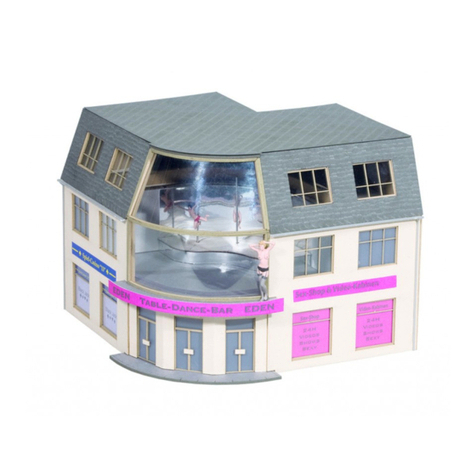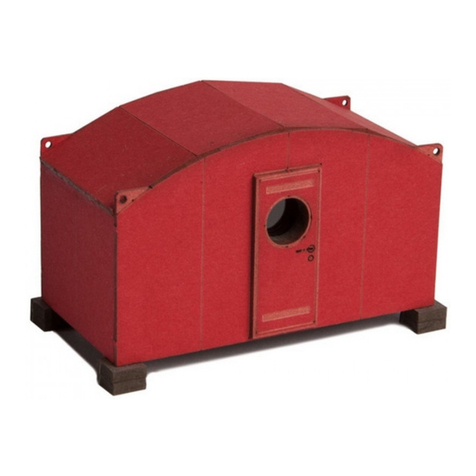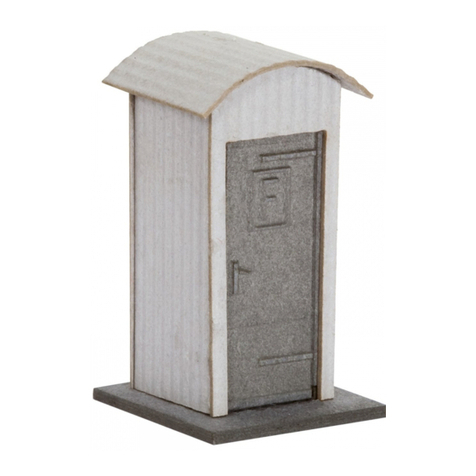
locomotief kan van ringen wisselen en is met de betreffende rijregelaar aan
te sturen.
LET OP: Dit is ook bij gebruik van twee locomotieven mogelijk (gevaar voor
botsing!).
De stadsverlichting kan met de knop worden in- en uitgeschakeld.
Is er op de modelspoorbaan een kortsluiting, dan schakelt de elektronica
de betreffende stroomkring uit. Zodra de kortsluiting is opgeheven, laat de
elektronica de stroom weer door naar de baan. (kortsluitherkenning!).
Let op!: Wanneer door elektromagnetische storingen van buitenaf de trein
tot stilstand komt, moet de trein weer gaan rijden zodra de storing voorbij is.
Wanneer dit niet het geval is, haal dan de netsteker uit het stopcontact en
start de trein opnieuw.
WEEE-Hinweis „Umweltgerecht entsorgen“
Produkte, die mit einem durchgestrichenen Mülleimer-Symbol
gekennzeichnet sind, dürfen am Ende ihrer Lebensdauer nicht über den
normalen Haushaltsabfall entsorgt werden, sondern müssen an einem
Sammelpunkt für das Recycling von elektrischen und elektronischen Geräten
abgegeben werden. Wir sind bei der Stiftung EAR (Elektro-Alt-Geräte
Register) registriert. Unsere Registrierungsnummer lautet: DE95117429.
Elektro- und Elektronikgeräte (EEE) und Elektro- und Elektronikaltgeräte
(Waste Electrical and Electronic Equipment, WEEE) können kostenfrei
zur Rücknahme zum stationären Handel oder zum Hersteller
geliefert werden.
Das Symbol auf dem Produkt, der Gebrauchsanleitung oder der Verpackung
weist darauf hin. Die Wertstoffe sind gemäß ihrer Kennzeichnung
wiederverwertbar. Mit der Wiederverwendung, der stofflichen Verwertung
oder anderen Formen der Verwertung von Altgeräten leisten Sie einen
wichtigen Beitrag zum Schutze unserer Umwelt. Bitte erfragen Sie bei Ihrer
Gemeindeverwaltung die zuständige Entsorgungsstelle.
Beachten Sie die örtlichen Bestimmungen zur Abfallbeseitigung.
Beachten Sie die WEEE-Richtlinie in ihrer derzeit aktuellen Fassung.
Entnehmen Sie vor einer Verschrottung des Produkts ggf. enthaltene
Batterien oder Akkus.
WEEE Note „Dispose of environmentally friendly“
Products marked with a crossed-out garbage can symbol must not be
disposed of with other household waste at the end of their working life,
but must be taken to a collection point for the recycling of electrical and
electronic equipment. We are registered with the foundation EAR (Elektro-Alt-
Geräte Register). Our registration number is: DE95117429
Electrical and Electronic Equipment (EEE) and Waste Electrical and Electronic
Equipment (WEEE) can be delivered free of charge to the stationary retailer or
manufacturer for take-back.
The symbol on the product, the instructions for use or the packaging
indicates this. The recyclable materials are recyclable according to their
labeling. By reusing, recycling or otherwise recovering old equipment, you
are making an important contribution to protecting our environment. Please
ask your local authority for the responsible disposal point.
Observe the local regulations for waste disposal.
Observe the WEEE directive in its current version.
Before scrapping the product, remove any batteries or rechargeable batteries
it may contain.
Model building item, not a toy! Not suitable for children under 14 years!
Article de modélisme. Ceci n’est pas un jouet.
Articolo di modellismo, non è un giocattolo!
Artículo para modelismo ¡No es un juguete!
Artigo para modelismo. Este artigo não é um brinquedo!
Výrobek urĉený pro modeláře, nejedná se o hračku!
Modelbouwartikel, geen speelgoed!
Modellbyggarartikel, detta är inte en leksak!
Elektro- und Elektronikaltgeräte sowie verbrauchte
Batterien gehören nicht in den Hausmüll, sondern
müssen fachgerecht entsorgt werden.
Puesta en marcha de su maqueta ferroviaria
en maletín
Encendido y apagado de la maqueta:
Conecte la fuente de alimentación adjunta conectándola primero a la conexión
de la fuente de alimentación en el sistema de maqueta en maletín y luego
enchufándola a una toma de corriente (tensión de entrada 100 – 240 V). ¡El
sistema ya está listo para funcionar! Artículo de modelismo, no de juguete!
Con el regulador de velocidad de color negro situado a la izquierda controla la
velocidad y la dirección de la locomotora en el círculo exterior 1. El
mando de control de la velocidad tiene una posición central táctil.
Con el botón negro de control de velocidad de situado a la derecha se
controla la velocidad y la dirección de la locomotora en el círculo interior
2. El mando de control de la velocidad tiene una posición central táctil.
Los circuitos interiores y exteriores de su maqueta están controlados por dos
reguladores de velocidad en circuitos independientes.
Para evitar que al pasar la locomotora de un circuito al otro se ocasione
un bypass eléctrico (derivación) de los dos circuitos y, en consecuencia,
se produzca un cortocircuito, los dos circuitos de la vía pueden estar
conectados entre sí.
Todas las unidades de tracción se controlan a través del regulador de
velocidad del circuito exterior 1. Tenga en cuenta que en este modo,
ya no es posible el control independiente de dos locomotoras en los dos
circuitos de vía hasta que vuelva al modo normal.
¡Para activar el recorrido de transición, pulse el botón 1+2 ! Púlselo de
nuevo para volver al control individual.
Nota: También es posible un cambio de circuito de vía si se aplica el mismo
potencial – el mismo sentido de la marcha – a ambos circuitos de vía.
La locomotora puede cambiar de circuito y es controlada con los respectivos
reguladores de velocidad.
Atención: Esto también es posible cuando se opera con dos locomotoras
(¡peligro de accidente!).
Puede encender o apagar la luz de la ciudad con el interruptor .
Si se produce un cortocircuito en el sistema, el sistema electrónico
desconectará la alimentación del circuito correspondiente. En cuanto se
elimina el cortocircuito, la electrónica permite que la corriente vuelva a fluir
hacia la vía. (¡Detección de cortocircuitos!)
Precaución: Si el tren se detiene debido a interferencias electromagnéticas
procedentes del exterior, el tren debe volver a arrancar en cuanto hayan
pasado las interferencias. Si no es así, desconecte el enchufe de la red y
vuelva a arrancar el tren.
In gebruik nemen van de modelspoorkoffer
In- en uitschakelen van de modelspoorbaan
Sluit de bijgevoegde adapter aan, nadat de netaansluiting is verbonden
met de kofferbaan, op de contactdoos van het net (100 – 240 V). De
modelspoorbaan is nu bedrijfsgereed! Modelbouwartikel, geen speelgoed!
Met de linker zwarte rijregelaar regelt u de snelheid en rijrichting van
de locomotieven in de buitenring 1. De regelaar heeft een voelbare
middeninstelling.
Met de rechter zwarte rijregelaar regelt u de snelheid en rijrichting van
de locomotieven in de binnenring 2. De regelaar heeft een voelbare
middeninstelling.
De binnen- en buitenring worden door twee rijregelaars onafhankelijk van
elkaar aangestuurd. Om een elektrische overbrugging van de beide ringen
door de locomotief en een daarop volgende kortsluiting bij het rijden van de
ene naar de andere ring te voorkomen kunnen de beide railringen met elkaar
verbonden worden. Alle locomotieven worden dan door de rijregelaar van de
buitenste ring 1 aangestuurd.
Let op: in deze mode is een onafhankelijke aansturing van twee locomotieven
op de beide ringen niet meer mogelijk, totdat wordt teruggekeerd naar de
normale mode. Druk op de knop om de overgang te activeren 1+2! Door
opnieuw op de knop te drukken wordt naar de normale mode teruggekeerd.
Aanwijzing: een railring wijziging is ook mogelijk wanneer bij beide
railringen hetzelfde potentiaal aanwezig is en dezelfde rijrichting. De













